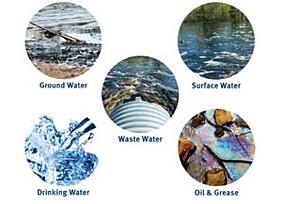Have you ever thought to yourself I wish there was one way to effectively extract all of our aqueous samples? For instance, there are several methods available to extract aqueous samples, such as extraction method 3510 liquid-liquid extraction (LLE), method 3520 continuous liquid-liquid extraction (CLLE), and method 3535 solid-phase extraction (SPE). Wouldn’t it be more convenient to use one extraction method within the lab for most if not all of your aqueous extractions?
Out of the three extraction methods, the one that is the most versatile is method 3535 solid-phase extraction. SPE is not only used for drinking water samples but is also used for groundwater and wastewater samples as well. SPE can be run manually or with automation making this a very versatile way to extract samples. SPE also accommodates various size disks and disk holders to adapt to your sample type.
Simplifying water extractions with SPE what to look for
When considering automating your SPE extractions you need an instrument versatile enough to extract drinking water samples as well as wastewater samples! You may be asking yourself, how can I possibly use the same instrument to extract batches of my heavily contaminated samples such as oil and grease and then use it for drinking water samples without contamination carryover?
SPE for drinking water
For drinking water samples, Biotage® offers two ways of extracting samples![]() with the Biotage® Horizon 5000. One way is with cartridges and the other way is with SPE disks. There are two different types of disk holders for use in your extraction: reusable and disposable. Check out our previous blog post which outlines the benefits of each and which option will best suit your laboratory. The Biotage® Horizon 5000 instrument can effectively and efficiently extract samples using cartridges or disks, whichever the method dictates for SPE.
with the Biotage® Horizon 5000. One way is with cartridges and the other way is with SPE disks. There are two different types of disk holders for use in your extraction: reusable and disposable. Check out our previous blog post which outlines the benefits of each and which option will best suit your laboratory. The Biotage® Horizon 5000 instrument can effectively and efficiently extract samples using cartridges or disks, whichever the method dictates for SPE.
SPE for groundwater and wastewater
Groundwater and wastewater samples are notorious for having a lot of matrix![]() issues and appear to look dirty due to large amounts of particulates in the sample. The functionality of an SPE instrument to clean all the internal lines while running these types of samples provides the versatility for a lab to then move back to extracting drinking water samples without having to worry about cross-contaminating the drinking water sample batch.
issues and appear to look dirty due to large amounts of particulates in the sample. The functionality of an SPE instrument to clean all the internal lines while running these types of samples provides the versatility for a lab to then move back to extracting drinking water samples without having to worry about cross-contaminating the drinking water sample batch.
SPE for oil and grease
The remaining wastewater methods include many from the 1600 series, for instance, EPA Method 1664B.
The Biotage® Horizon 5000 is an all-in-one extraction system for extracting all types of water samples. To see a sample of its versatility, download our recent application note that highlights the recovery levels from the initial precision and recovery measurement samples. There was little to no variability in the instrument’s ability to recover oil and grease across all stations as well as the fact that the recoveries fall within the high 90s.
One method extraction
With one extraction system, you can extract oil and grease samples which may contain up to 1 gram of oil and grease, use the cleaning functions of the Biotage® Horizon 5000 along with proper glassware, washing practices, and the appropriate disks holders and collection flasks to confidently extract a batch of drinking water samples.
may contain up to 1 gram of oil and grease, use the cleaning functions of the Biotage® Horizon 5000 along with proper glassware, washing practices, and the appropriate disks holders and collection flasks to confidently extract a batch of drinking water samples.
With the increased solid-phase extraction capability, your lab can streamline extractions to utilize method 3535 only (as long as the EPA method you are following permits that adjustment). This streamlined approach of extracting aqueous samples will free up more time for your analyst to complete other tasks – that are not so easily automated.
For more helpful information including how to tips, click on the link below!

